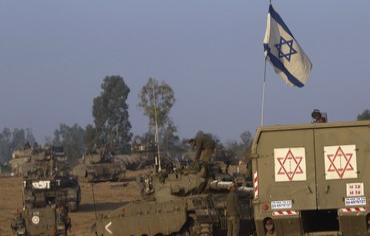
IDF tanks and a flag on the Gaza border Photo: Ronen Zvulun / Reuters
This November, southern Israel marks one year since the IDF’s Operation Pillar of Defense in the Gaza Strip. It has been the quietest year in quite awhile, with “only” 79 rockets and missiles fired at southern Israeli communities. This is the fourth cease-fire between Israel and Hamas in the past seven years, the first having been on November 26, 2006.
Southern Israel has sustained hundreds of rocket attacks during these cease-fires. The last cease-fire lasted from the end of Operation Cast Lead on January 18, 2009, to the first day of Operation Pillar of Defense on November 12, 2012. During that period, approximately 2,000 rockets and missiles were fired from Hamas-controlled Gaza, sending one million Israelis running to shelters with between 15-45 seconds’ warning.
According to Israeli intelligence sources, there are still thousands of long-range missiles hidden deep within Gaza’s civilian buildings and infrastructure. In Operation Pillar of Defense Iranian Fajar missiles were fired near the Shifa hospital in Gaza toward Jerusalem. Israel renovated the Shifa hospital in the 1980s.
The Iron Dome missile defense system received a great deal of media attention during and after Pillar of Defense, with many suggesting that this was the military solution for the rocket fire from Gaza. While there is no doubt this system has brought about a change in the strategic warfare combating Hamas, it has definitely not solved the problem of rocket fire – far from it.
During Pillar of Defense there were five operational batteries intercepting missiles in mid-air. As there are hundreds of midsized towns and cities in southern-central Israel within 75 km. of Gaza, it has been always a game of “Russian roulette” as to what areas or cities the “Iron Dome” could protect.
The Iron Dome does not protect the western Negev communities and the section of Sderot that is up to 4.5 km. from the Gaza border, because the 15 seconds it takes from the time an advanced Kassam rocket is fired until in impacts in these communities is just not enough time to intercept the rocket.
Thus, a “creative solution” has been proposed: for Sderot and the western Negev communities to turn into the bomb shelter capital of the world. NIS 500 million were invested in Sderot alone to build 6,000 new bomb shelters, and up to $500m. to protect the western Negev communities in the 4.5 kilometer radius, including public buildings and schools.
As director of the Sderot Media Center for seven years, I can attest to the fact that Israel has not provided a solution to the rocket- fire or threat, and that we should expect many more years of living through rocket and missile escalations, in addition to years of rehabilitation for an entire population that has entered its 14th year of living under threat.
The current relative quiet in the western Negev has resulted a near-absence of attention being payed to the Hamas-controlled Gaza element in the current peace talks.
The two-state solution remains high on the agenda of the Israeli government, as well as the focus of the Israeli media. However, hardly any mention is made of the Hamas state established in Gaza after the one-sided Israeli “land for peace” move in August 2005, leaving Gaza empty of a Jewish presence, civilian or military.
Ben-Gurion Airport, Israel’s only international airport, is less than three kilometers from the western Judean mountains. The Sderot case has taught us that the most advanced technology in the world cannot stop a Kassam rocket that is only in the air for 15 seconds.
How many Israelis will live within 15 seconds’ rocket flight from a demilitarized Palestinian state? Hamas today is in control of the entire Gaza strip and its population of 1.7 million Palestinian Arabs. Hamas makes sure to remind Israel and the rest of the world that they won US and EU-supervised elections in all the Palestinian territories in January 2006.
Since then, there have been no elections.
So who does Abbas actually represent? In April, 2013, during US President Obama’s visit to Israel, on his second-day visit to Ramallah, Hamas fired five rockets at southern Israel, two exploding into Sderot. One rocket exploded underneath a children’s bedroom, and one exploding in a kindergarten.
This took place during Passover vacation, so no there were no casualties, but the attack barely received media attention.
One million Israelis in southern Israel living within missile range of Hamas-controlled Gaza are asking themselves: “If Hamas and the rocket fire and threat not part of the current negotiations and peace talks, how is it possible to reach an agreement? Could we reach the absurd situation in which ‘peace’ is achieved and the rockets continue to be fired?” The more we ignore the conclusions and policy implications of Operation Pillar of Defense the more illusions we build.









